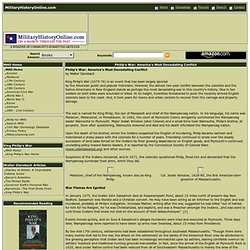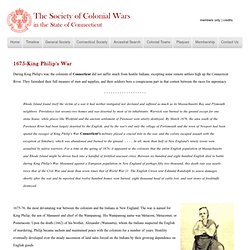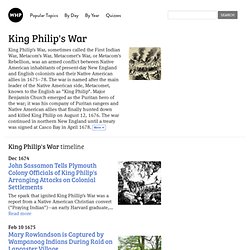

Military History Online - King Philip's War. Philip's War: America's Most Devastating Conflict by Walter Giersbach King Philip's War (1675-76) is an event that has been largely ignored by the American public and popular historians.

However, the almost two-year conflict between the colonists and the Native Americans in New England stands as perhaps the most devastating war in this country's history. One in ten soldiers on both sides were wounded or killed. At its height, hostilities threatened to push the recently arrived English colonists back to the coast. And, it took years for towns and urban centers to recover from the carnage and property damage. New England’s Second Colonial Armed Conflict: King Philip’s War Remembered. In 1668 and 1669, Metacom or King Philip, was given the name by the English after the classical Greek conqueror “for his ambitious and haughty spirit;” and the title “King” to exaggerate his role in the war that bore his name.

Philip was asked to sign a waiver of any land claim to ancient Wampanoag territories that would allow for full European expansion. This transparent and audacious request was met with refusal and tensions only mounted. In 1671, English authorities demanded Philip surrender his arms and “voluntarily” give up more land. In 1673, Peter Talman of Mount Hope, Rhode Island “won” his legal claim to more Wampanoag land. The crisis was at fever pitch in 1674 when a soldier of Metacom assassinated an Indian collaborating with the English. In 1675 in the Dartmouth area at Poneganset, being promised to be fairly treated, the Indians surrendered as requested. The approach learned at the Pequot Massacre (1636-38) was to be repeated. Redemption of Captives. If you have not already done so, read about the attack on Hatfield On September 19, 1677, attacking Amerindians left Hatfield in chaos!

Seventeen hostages were taken, 7 houses and barns burned, 12 villagers killed, and 4 wounded. How could the captives be rescued? Who had taken them? Where were they being taken? One man, Benjamin Waite, a scout who knew how to survive in the woods, knew what he was going to do. December 16, 1677 - Lake Champlain was reached, the first time English colonists had set foot there. The English remained in Canada until the winter weather was over. "Albany, May 22, 1678. Excerpted from Wells and Wells (1910), p. 96 "Albany, May 23, 1678. "At Albany, written from myne own hand. On receipt of the letters, a party from Hatfield immediately set off to escort the exhausted group home. References: Wells, D. The Society of Colonial Wars in the State of Connecticut - 1675 King Philip's War. 1675-King Philip's War During King Philip's war, the colonists of Connecticut did not suffer much from hostile Indians, excepting some remote settlers high up the Connecticut River.

They furnished their full measure of men and supplies, and their soldiers bore a conspicuous part in that contest between the races for supremacy. Rhode Island found itself the victim of a war it had neither instigated nor declared and suffered as much as its Massachusetts Bay and Plymouth neighbors. Providence lost seventy-two homes and was deserted by most of its inhabitants. Warwick was burned to the ground except for one stone house, while places like Wickford and the ancient settlement of Pawtuxet were utterly destroyed. King Philip's War timeline. King Philip's War, sometimes called the First Indian War, Metacom's War, Metacomet's War, or Metacom's Rebellion, was an armed conflict between Native American inhabitants of present-day New England and English colonists and their Native American allies in 1675–78.

The war is named after the main leader of the Native American side, Metacomet, known to the English as "King Philip". Major Benjamin Church emerged as the Puritan hero of the war; it was his company of Puritan rangers and Native American allies that finally hunted down and killed King Philip on August 12, 1676. The war continued in northern New England until a treaty was signed at Casco Bay in April 1678. More. King Philip's War. The war was the single greatest calamity to occur in seventeenth-century Puritan New England and is considered by many to be the deadliest war in American history.[5] In the space of little more than a year, twelve of the region's towns were destroyed and many more damaged, the colony's economy was all but ruined, and its population was literally decimated, losing one-tenth of all men available for military service.[6][7] More than half of New England's towns were attacked by Native American warriors.[8] Nearly all the English colonies in America were settled without any significant English government support, as they were used chiefly as a place of refuge or exile for religious minorities and other rebels in England.

King Philip's War. p245 Chapter XV The information given to Henchman by his captives in respect to the departure of Philip, was correct.

Accompanied by the remnant of the Wampanoags and many Narragansetts he had turned in desperation again toward his own country. Safety was no longer possible, either in the valley or at Wachusett. King Philip's War ***